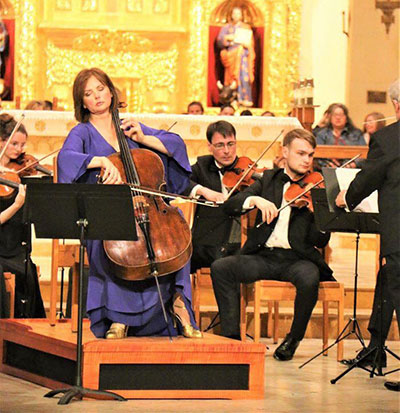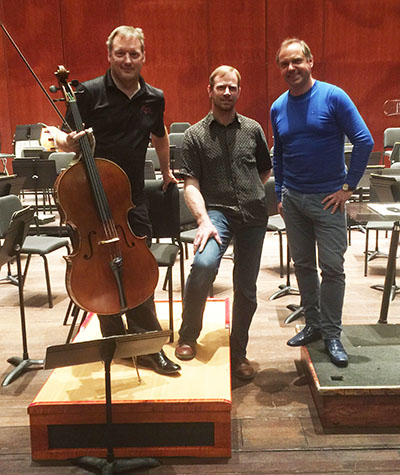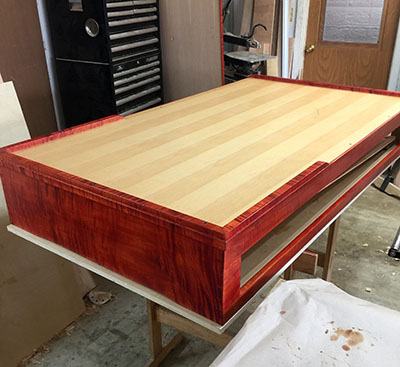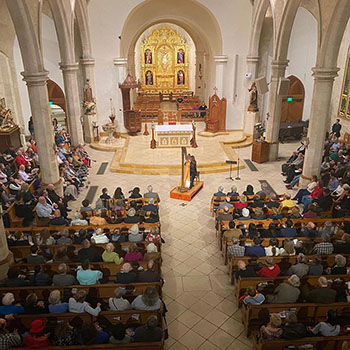
Frank Strazza’s cello podium in use by Nina Kotova at a concert in San Antonio’s San Fernando Cathedral for Musical Bridges Around the World. Photo Credit: Ramiro M. Aguinaga Sr
Feb 26, 2020–Sometimes an idea is so elegant, it is discovered more than once.
Such is the case with the “cello podium.”
This platform cum amplifier started as a rumor uncovered by Ken Freudigman when he was a cello student at Eastman School of Music back in 1985. The musician had heard stories of a stagehand whose father had designed an acoustic cello podium. This was more than just a platform to raise up the cello player. It was an instrument in itself, designed with a soundboard and sound post to take the output from a bowed cello and amplify it above the orchestra.
“There were stories that one was made, that everyone loved it, and then it disappeared,” said Freudigman.
Even as he carved out a performance career as principal cellist with the San Antonio Symphony and co-founder of the classical ensemble Camerata San Antonio, Freudigman never forgot the mystery of the lost instrument. Twenty years later, with the advent of the internet, Freudigman played a hunch and began searching acoustical historical sites online. Eventually he stumbled across the plans.
The story could have ended there, and in fact Freudigman filed and forgot about the drawings. Until one day he was preparing for a solo with the San Antonio Symphony. He resurrected the plans for a cello platform. Now all he needed was someone to build it.
He found perhaps the best person in the musical universe to do that. Freudigman recalled meeting Frank Strazza at a Camerata San Antonio concert. Along with being an accomplished cellist, Strazza is a master-level woodworker based in Bandera. He crafts fine works using hand tools and time-honored techniques.
“I said, hey, Frank, would you be interested in making this thing,” Freudigman recalled. “He, being a cellist, was thrilled. I couldn’t think of anyone else who could do this. His craftsmanship is off the charts. There is not a nail in this thing.”
Before Strazza could start building, he had to decipher the plans.
“Ken had a faded copy of a drawing drafted in 1963,” Strazza said. “I tried to find more plans, but couldn’t find anything. So I had to interpret this one page, faded drawing into the box we have now.”

The cello podium under construction. Strazza used the same woods used in violin-making–spruce, fir, and curly maple.
Strazza got to work. He played around with the original plans, making modifications using experience he had gained from a lifetime of crafting. He fashioned a soundboard from quarter-sawn spruce, curving it to simulate the top of an instrument. He installed a sound post to connect the soundboard to the top, to amplify the sound as an instrument would. He left the sides open with a fabric covering to allow the sound to be projected outward to the audience. He used the same woods used in violin-making–spruce, fir, and curly maple.
Freudigman now has the podium in his possession. He has used it for concert performances, and is entranced.
“The cello by itself is a very beautiful and powerful instrument, but the range in which it lies can be covered up by an orchestra, even if you are a loud player,” Freudigman said. “This podium actually helps amplify the sound, because the box itself is a musical instrument. And while it amplifies the sound, it also maintains the timbre and color of the instrument, just helping to project the frequency in a better way.”
Strazza is experimenting with modifications to make it more economically viable for the average cellist. But he has no interest in “assembly line” work.
“This is a glorified box,” Strazza noted. “Actually I am more intrigued with instrument making, that’s what I do. This is more about the fine art of combining music and wood–that is the passion where my worlds collide.”
For now, Strazza’s cello podium may be the only one of its kind in the world. While there have been others, none rise to this level of complexity.

Ken Freudigman (left) tries out the podium built by Frank Strazza (center). On right is Sebastian Lang Lessing, conductor of the San Antonio Symphony.
“I hope for Frank to be able to build more of them,” Freudigman said. “It is a real asset for cellists. It is not cheap, but for orchestras it would be a very good investment. Any box can elevate the cellist and project the tone of the instrument, but this version has the internal workings to do that better.”
Added note from Frank Strazza:
“I originally built this acoustic podium to be used for cellists, but I never thought it would be used by a harpist. Coincidentally Bridget Kibbey has been called the Yo-Yo Ma of the harp, so it’s only fitting that she would use a cello podium! She performed last night in the beautiful historic San Fernando cathedral in San Antonio, Texas, as part of the Musical Bridges Around the World concert series. The podium is built from curly maple and has an internal quartersawn tonewood soundboard that is curved to help enhance the tone of the performer’s instrument.”



